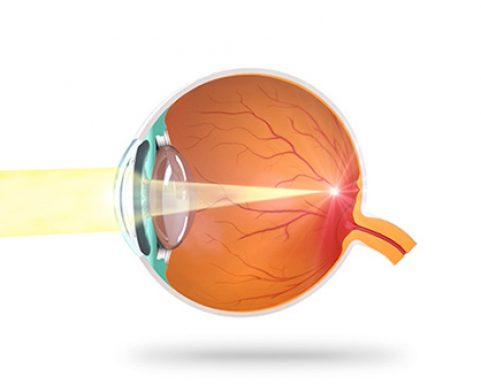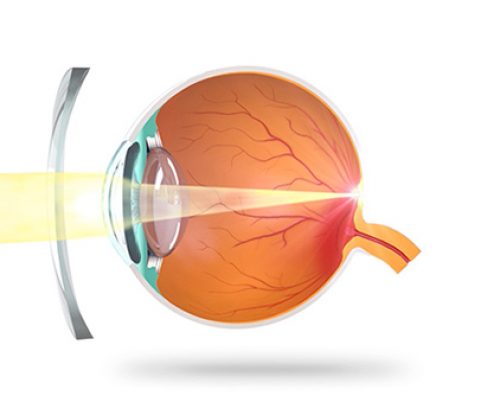Myopia
Once pictured
MYOPIA
Myopia affects 30.6% of the European population today, with more and more younger people, in particular, now diagnosed at increasingly younger ages. Myopia is primarily connected to environmental and genetic factors. Nearsighted people have blurry vision in the distance and sharp vision in the near.

Myopia: Definition
When it comes to myopia, the eye is too long in reference to its refractive index, or its refractive index (ability to focus beams of light on a single point) is too strong in reference to its length.
The image of a distant object therefore forms in front of the retina, which leads to blurry vision in the distance.
The stronger the myopia is, the shorter the distance of sight. Punctum remotum, which refers to the farthest point from the eye at which images are clear without accommodation, is extremely far away for an eye without visual impairment. For a nearsighted eye, it’s less than 5 meters away.
Myopia is considered to be weak between –1.00 and –3.00 dpt, medium between –3.00 and –6.00 dpt, and strong above –6.00 dpt.
When it comes to myopia, the eye is too long in reference to its refractive index, or its refractive index (ability to focus beams of light on a single point) is too strong in reference to its length.
The image of a distant object therefore forms in front of the retina, which leads to blurry vision in the distance.
The stronger the myopia is, the shorter the distance of sight. Punctum remotum, which refers to the farthest point from the eye at which images are clear without accommodation, is extremely far away for an eye without visual impairment. For a nearsighted eye, it’s less than 5 meters away.
Myopia is considered to be weak between –1.00 and –3.00 dpt, medium between –3.00 and –6.00 dpt, and strong above –6.00 dpt.
Myopia: Causes and symptoms
The following are the three primary causes of myopia:
-Hereditary myopia is responsible for a majority of cases.
-Special circumstances can increase myopia. Adults and children who frequently use their near vision (work, reading, digital screens) overexert their ciliary muscle, which is responsible for accommodation. These contractions result in micro spasms that reduce the curvature of the lens and thus increase myopiae.
– A lack of sunlight is another cause of myopia especially among children, as the retina is exposed to less dopamine, which is a neurotransmitter. But dopamine also prevents excessive eye growth.
The following are the three primary causes of myopia:
-Hereditary myopia is responsible for a majority of cases.
-Special circumstances can increase myopia. Adults and children who frequently use their near vision (work, reading, digital screens)

overexert their ciliary muscle, which is responsible for accommodation. These contractions result in micro spasms that reduce the curvature of the lens and thus increase myopiae.
– A lack of sunlight is another cause of myopia especially among children, as the retina is exposed to less dopamine, which is a neurotransmitter. But dopamine also prevents excessive eye growth.

Correcting myopia
Myopia can be corrected with concave single vision lenses, which enable the creation of a sharp image by focusing beams of light directly on the retina. The stronger the myopia, the thicker the lenses are along the edges. Increased index and aspherical single vision lenses can ensure a thinner design that is more attractive and aesthetic.
The corresponding lens
A lens tailored to your specific visual impairment
THE MONOVID FREE-FORM SINGLE VISION LENS

A combination of precision and lightness.
